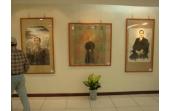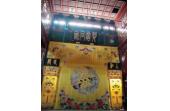Huguang Guild Hall
- Things to do
-
- Photo(11)
- Tips&article(5)
- Make it Happen
- Map
-
loading...
- Other Tours
-
- Shibaozhai
- Zhazi Cave
- Ciqikou Old Town
- The Huangjueping Doodle Art Street
- Huangjueping Graffiti Street
- The Great Hall of the People in
- Fengjie Natural Pit
- Loquat Mountain Park
- People Liberation Monument
- Wulong Karst Region
- Great Hall Of The People
- Chongqing Zoo
- Chongqing
- Wuming Que and Dingfang Que
- Lesser Three Gorges
- White Emperor City
- Hongyan Revolutionary Memorial Museum
- Dazu Grottoes
- Simianshan Tourist Attraction
- Goose Neck Park
Overview
The Huguang Guild Hall is an old complex of buildings that was a cultural, business and social center for more than 200 years. When people came from other provinces to settle in the region during the Qing Dynasty, they built guild halls. The Huguang Hall was built for people from Hubei, Guangdong, Guangxi and Hunan.
The complex was opened for tourists after renovation in 2005. Many theatres, opera stages and shrines can be seen. There is a museum and shops for handicrafts. There are performances of Sichuan Opera “Magical Face Changing” in which the actors change the masks that they are wearing by slight of hand or with a wave of their hands.
This old hall complex has been refurbished and renovated, and it may be an interesting place to visit to see the architecture, watch performances, eat and shop.
Detailed Description
It is a complex of halls, meeting rooms, courtyards, theaters, gardens and rooms. This complex of rooms and halls served for business, entertainment, religious and social activity and as a meeting place for people from the provinces in the southeast and east. So various buildings have identifying names like Guangdong Hall for people from Guangdong Province in the far southeast corner of the China mainland where Hong Kong is now.
Other halls are called Jiangnan Hall (江南会馆) that means “south of the river” for people from the area south of the Yangtze River; Lianghu Hall (两湖会馆) that means “the two Hu provinces” meaning Hunan Province and Hubei Province; and the Jiangxi Hall (江西会馆) for people from Jiangxi Province. There is a temple there called Yuwanggong where people used to pray for harvests.
There is also a city gate outside the complex called Dong Shuimen that is one of Chongqing’s best preserved city gates.
Location: 4 East Shuimen Street (东水门正街 East Water Gate Street) The Dong Shuimen (“Eastern Water Gate”) is one of Chongqing’s best preserved city gates. It is just outside the guild hall complex. East Shuimen Street is in the far eastern part of the old city area that is now called the Yuzhong District. It is near the river and is next to a major avenue called Changjiang Binjiang Road that goes follows the river’s bank.
History
A building was first built in 1759 during the reign of Emperor Qianlong in the ancient city area near an eastern gate of the city along the Yangtze River. It was damaged by fire, and a complex grew that was renovated and expanded many times. Settlers from the east and south of China and their descendents wanted to meet there. They moved to the area because the Qing Dynasty rulers wanted Sichuan settled. Chongqing was then a part of Sichuan.
Millions of people died in the area during the last decades of Ming rule and when the Manchus invaded. There was a big population decline in China at the end of the Ming Dynasty and at the beginning of the Qing Dynasty associated with the Little Ice Age period and the conquest of China by the northern Manchu tribe of the Qing Dynasty (1644-1912).
There were famines, plagues and wars. It is said that only 800,000 people remained in Sichuan at the beginning of the Qing Dynasty. A museum in the complex instructs on the history of the westward migration and the building of the Huguang Guild Hall.
Features:
- Old architecture. Some of the construction is more than 200 years old.
- Renovated for opera, traditional music and theater performances.
- A museum about the westward resettlement.
- Restaurants and shops.
- Dong Shuimen gate is just outside the complex. It is one of Chongqing’s best preserved city gates.
Touring Activities:
- Learn about Chinese architecture styles, social activities, and religion.
- Learn about the history of Sichuan and Chongqing.
- Photography.
- Watch theater performers, opera, musical performers, acrobats and other entertainment.
- Enjoy the tea and food in the teahouses and restaurants.
- See the preserved Dong Shuimen city gate.
- You can cross over Changjiang Binjiang Road and see the river and walk along the narrow park area on the bank.
Nearby Attractions:
Around the city area, there are several tour highlights. For more shopping, “Face Changing” Sichuan Opera, and restaurants, there is a small pedestrian area composed of two city streets and alleys called Ciqikou to the northwest along the Jialing River. Other nearby attractions include the Three Gorges Museum, the Great Hall of the People, and Chongqing Zoo.
Tips & articles
|
|
|
forum discussion
|
|











